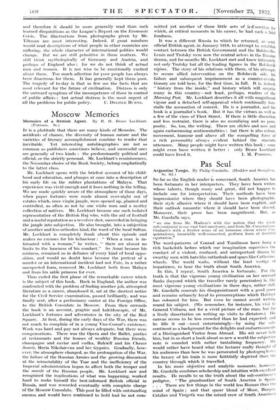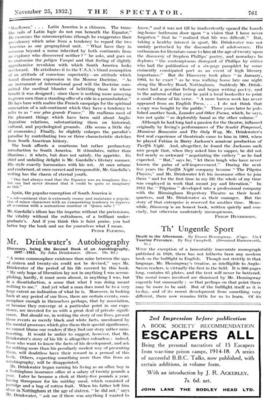Pas Seul
So far as the English reader is concerned, South America has been fortunate in her interpreters. They have been writers whose talents, though many and great, did not happen to include one for interpretation. Their methods have been impressionist where they ,should have been photographic. their style allusive where it should have been explicit, and their outlook romantic where it should have been shrewd.
Moreover, their prose has been magnificent. But, as Mr. Guedalla says,
'we rise from Mr. Hudson's with the notion that the whole sub-continent is one vast bird sanctuary, and from Mr. Cunningham; Graham's with a livelier sense of an immense circus where Con- quistadores, invariably well-connected, perform feats of doubtful equitation.'`
The word-patterns of Conrad and Tomlinson have hung a - rich backcloth before which our imagination supervises the conduct of a violent, confused, and unimportant drama by swarthy men with hats like cathedrals and spurs like Catherine- wheels. The world waits, without the least vestige of impatience, to hear the truth about South America. In this, I repeat, South America is fortunate. For the truth is that the vigorous young civilization on her seaward flanks (beyond which the traveller rarely penetrates) is, like most vigorous young civilizations in these days, rather dull. Mr. Guedalla conceals his disappointment with a good grace and remains urbanely loyal to preconceptions which Hakluyt has coloured for him. But even he cannot avoid writing round his subject. (We remember, for instance, his visit to General Uriburu, not for a vivid picture of the man, but for a lively dissertation on writing up visits to dictators.) His canvas seems to be less crowded than he had expected, and he fills it out—most entertainingly—by using the sub- continent as a background for the delights and embarrassments of a Distinguished Visitor from Abroad. His wit never fails him, but in so short a book about so new a world the subjective note is sounded with rather tantalizing frequency. We would rather have heard what the lecturer really thought of his audiences than how he was persecuted by photographE-rs the luxury of his train is more faithfully depicted than the country through which it travelled. In his more objective and analytic moments, however. Mr. Guedalla combines scholarship and intuition with excellent results. He recalls to us the truth about the sub-continent's pedigree. " The 'grandmother of South America is Spain. . . . There are few things in the world less Roman than the mind of Spain ; and that queer blend " of ',Moor, Basque, Catalan and Visigoth.was the mixed crew of South America's
Mayflower.' . . . Latin America is a chimera. The tram- like rails of Latin logic do not run beneath the Equator."
He exorcizes the misconceptions (though he exaggerates their prevalence) which arise from a tendency to regard the two
Americas as one geographical unit. "What have they in common beyond a name inherited by both continents from
an explorer who discovered neither ? " he asks, and goes on to anatomize the peligro Yanqui and that feeling of slightly
apprehensive revulsion with which South America looks northward. He attributes it to the U.S.A.'s bland assumption of an attitude of conscious superiority—an attitude which found disastrous expression in the Monroe Doctrine. As an instrument of international good will the Doctrine com- mitted the cardinal blunder of belittling those for whose
benefit lt was designed ; since there is nothing more annoying to grown men than a standing offer of a ride in a perambulator." He lays bare with malice the French campaign for the spiritual annexation of a sub-continent which they have a tendency to refer to as " une plus grande Prance." He reaffirms most of
the pleasant things which have been said about Anglo- Argentine relations, substantiating them on historical, cultural, and psychological grounds. (He seems a little shy of economics.) Finally, he slightly enlarges the parodist's paradise by contributing two or three characteristic sketches from South American history.
The book affords a courteous but rather perfunctory introduction to South America. It stimulates, rather than illumines ; it whets, but does not satisfy, the appetite. Its chief and unfailing delight is Mr. Guedalla's literary manner. His style exactly harmonizes with his wit. At once urbane and exuberant, at once correct and irresponsible, Mr. Guedalla's writing has the charm of eternal youth.
"One had always read that the Equator was an imaginary line : hut one had never dreamt that it could be quite so imaginary as this."
Again, the popular conception of South America is "a sub-continent that is extremely roomy and maintains a popula- tion of minor characters with an exasperating tendency to improve all occasions with a sententious murmur of Quien sate ? ' "
Mr. Guedalla's idiom has the impetus without the pretensions, the vitality without the coltishness, of a brilliant under- graduate's. And if you think this is faint praise, you had
better buy the book and see for yourselves what I mean.
PETER FLEMING.







































 Previous page
Previous page